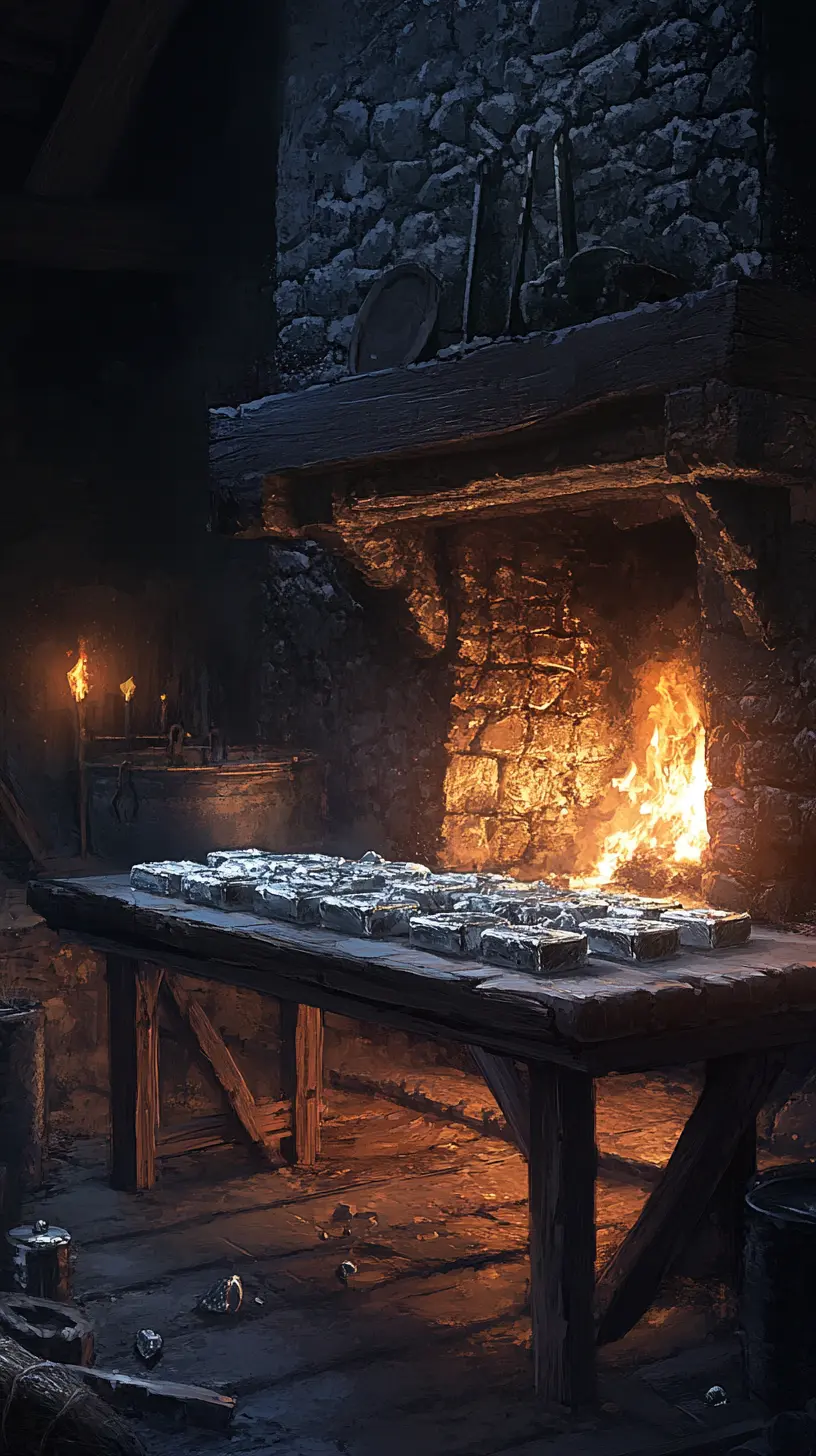Dirinnium
I had thought my blade to be dull, but this..!Dirinnium, also known as swindler's silver, is an uncommon naturally-occurring semi-precious metal derived from dirinnite ore. Found most commonly in hydrothermal mineral deposits alongside garnets, quartzes, and copper, it is often mistaken for silver due to their extreme visual similarity and a number of their shared properties.
It has been the cause of much frustration over the years. While silver is an incredibly magically-conductive material with strong effects against certain enemies, like devils, dirinnium has no similar effect and is indeed a magic absorber.
When magic is channeled into it, it either nullifies it or redirects it immediately, which can be a complete pain when deep into the enchanting process.
Merchants and metalworkers alike run into constant issues with swindler's silver. As a more common metal than silver, those unfamiliar with its existence (or deciding to become the titular swindlers) frequently trade it and goods made from it as if they are silver. When some uses of silver can be incredibly delicate, as mentioned, this could be a very dangerous (or very expensive) mistake for any worker or trader to make.
After all, dirinnium has some fantastic reactions, and warps under pressure in a very odd manner.
Properties
Physical & Chemical Properties
I mean, it's great if you just need something that looks like silver.For the most part, swindler's silver looks and behaves like actual silver - with some differences. Dirinnium is a softer and more reactive metal, and thus despite boiling at approximately the same temperature as silver, it begins to melt far sooner. For artisans with a careful eye, this is the easiest tell that the silver they were sold was either an alloy of dirinnium and silver, or was not silver at all.
Silver is highly conductive. Dirinnium is less so, more comparable to copper with electricity and behaving entirely differently with magic as previously mentioned.
Its magic absorption properties have been a curious source of research for some alchemists and metallurgists; it is currently being investigated to determine whether it could be used to store magic for longer periods of time if alloyed with other materials. When used alone, dirinnium tends to react unpredictably and often violently.
While dirinnium tarnishes much like silver, it takes far longer to do so, and oxidises to a more pale white-like coating rather than the dark blemishes of silver.
This has been a surprisingly favourable property for jewellers seeking to make jewellery of silver colour but without requiring the level of care silver can need, though this must also be weighed against the impact of its other properties.
History & Usage
History
Please don't tell me you've spent all this time working on my masterpiece only to use swindler's silver?! It's going to destroy the Polyhedric Powerglass!Dirinnium has been used throughout known history ever since mining of hydrothermal deposits began. Though its formation is not common and is more likely in areas of significant volcanic activity, it has nonetheless been part of the metals trade for a long time - perhaps as long as silver itself, given that it is more common than its long-lost sibling. The downsides of dirinnium - its softness, reactivity, absorption, and the odd effects under force - have long prevented its use in most industrial contexts, as a building cannot be built on a structure that might fall over if someone is thrown into its wall.
However, it finds a lot of use in magical experimentation and security, and its alloys with other materials have been able to counter its downsides - especially its reactivity - enough to enable use in some permanent structures.
History is also littered with incidents of cut costs causing disasters because of dirinnium. Sacred relics have been replaced with dirinnium forgeries many a time, leading to dangerous incidents if those relics are used in ceremony.
While the time a Gildón church found out that a sacred hammer had been replaced by the way it went floppy in the middle of a wedding was hilarious, the explosion that ripped through a Vostene village when their new silver chalice dipped into their highly acidic holy wine was not.
There has also been some progress in using it medicinally in recent history. Clerics in Celesthem Temple have been testing its magic absorbent properties with magical poisons and diseases.
Perhaps we'll find more secrets if we keep playing with it...
Compounds
When playing with dirinnium, the first thing to keep in mind is that one should never assume it will react the same way as silver. Dirinnium nitrate is a flaming toxic substance of little use outside of destruction, the direct opposite to silver nitrate, and while silver chloride is useful for its photosensitivity and warding abilities, dirinnium chloride instead produces a corrosive substance capable of eating magic at the cost of producing deadly gases. Interestingly, alloying dirinnium with silver produces a slightly more stable version of dirinnium capable of withstanding more force, and that is entirely magically inert. It does not tarnish, and is frustratingly inflexible when trying to work it. It is commonly produced while trying to fake silver shipments by cutting them with bars of dirinnium. Dirinnium sulfide is often produced naturally in the veins dirinnium is mined in. It resembles a white ash, and is known to miners as cloudash for the white fumes it gives off if disturbed. Its only known use currently is in alchemy as a reagent for wind spells. Intriguingly, alloying dirinnium with certain magical materials causes unique effects. Perhaps ask an alchemist what happens if you alloy it with istralite. Their reaction should be enough.I'm going to send letters out through the whole world so everyone knows how terrible that bloody trader's alleged silver is. It burned down my bloody shed! All I did was knock a bloody drink onto it for half a second!












It must be some kind of omen if the sacred hammer goes floppy during your wedding. XD
Explore Etrea | WorldEmber 2025
all the couples in the room stifling giggles about how the honeymoon's gonna be pretty disappointing x)
welcome to my signature! check out istralar!